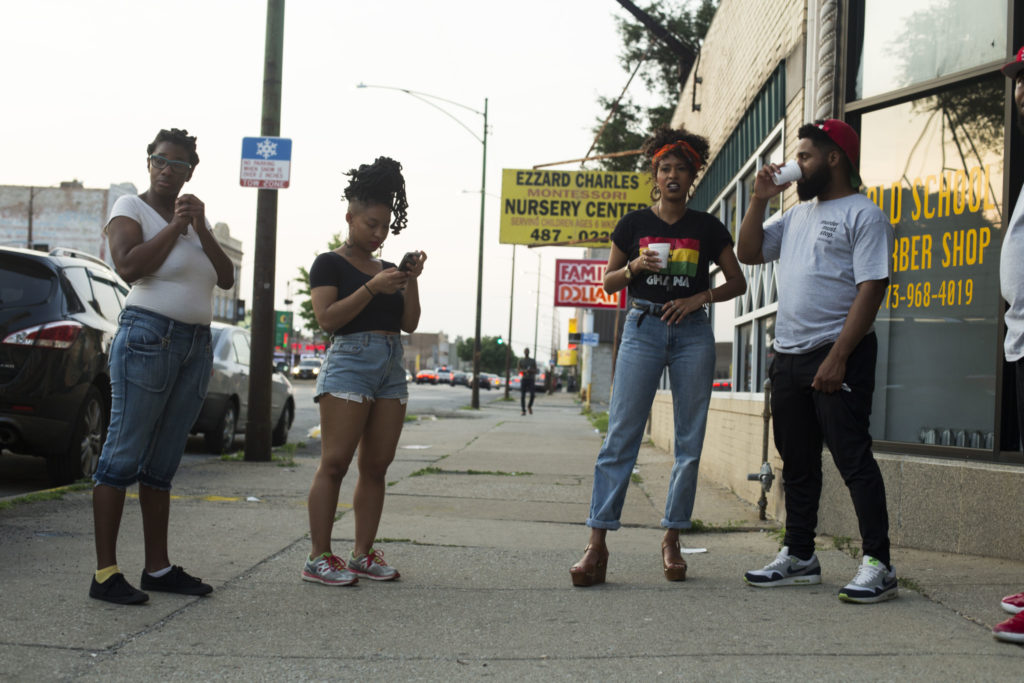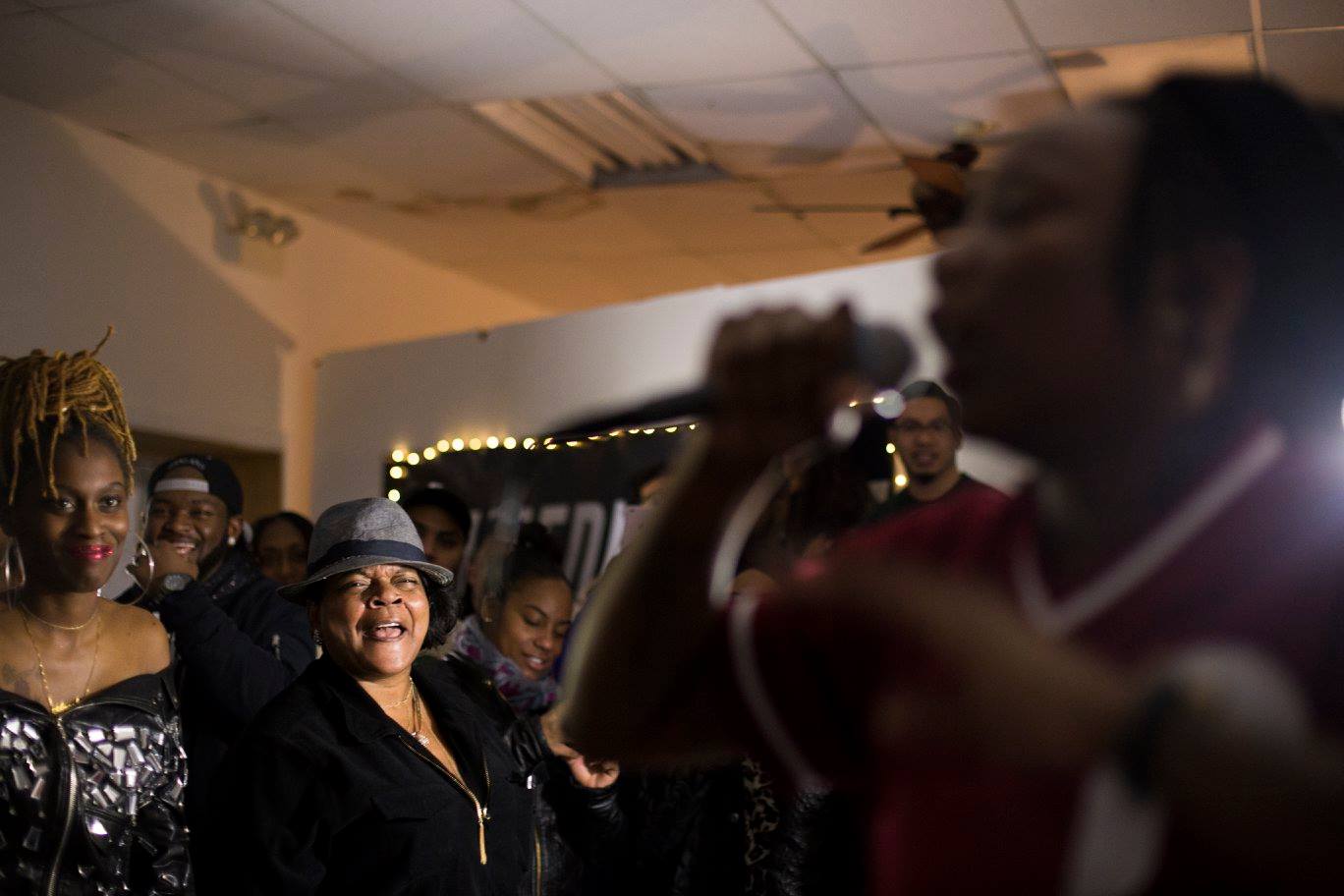Last summer, restorative justice clothing brand store TRAP House Chicago, in East Chatham, was full of musicians, poets and rappers. If there were any strangers at the monthly spoken word event no one would’ve known. Known simply as “People Say,” the event felt like a family gathering for the creative community on the South Side: eager artists showcased their musical talent and poetry over light snacks in a cathartic space designed to bring like-minded young creatives together.
Founded by spoken word poet and documentary filmmaker Resita Cox in 2018, People Say is a monthly open mic made in partnership with TRAP House Chicago founder and designer Mashaun Hendricks. But for the past year, Cox hasn’t been able to host any gatherings because of the pandemic—the last open mic was in August 2019.
Earlier this fall, with COVID cases slowing down, Cox was planning to bring back People Say, but with fewer people in the space—and then the third wave of COVID hit in November and she had to postpone. Keeping her community physically safe had to take priority to her art and fostering community on the South Side.
The pandemic has laid waste to in-person community building for Black artists who view their practice as a form of community organizing, collective care, and resistance. “Isolation is a tool of colonization, our oppressors want us to be isolated because there’s power in community,” she said. Art is an integral part of the city’s culture that’s necessary to make Chicagoans on the South and West Sides feel alive, especially during a time where there’s been a sharp rise in suicides among Black Chicagoans.
Cox, like many Black artists, has been forced to maneuver through strict social distancing guidelines to keep her practice going amid the COVID-19 pandemic and the worst city financial crisis in years. As of November 19, the COVID-19 death rate among Black Chicagoans was the highest among the city’s four largest racial or ethnic groups and nearly double that of the city’s white residents, according to a WBEZ report.
COVID-19 hit Black communities hard, and not just in terms of positive cases. It’s also an economic nightmare for people working in arts and culture. It’s forced some arts entrepreneurs in underrepresented communities to rely on creative solutions to survive and to deal with the disparities that have been further exacerbated by the pandemic. For Black Chicagoans this means tapping into their resiliency—the same resiliency that has made these communities flourish for decades amid disinvestment.
Vershawn Sanders-Ward is the owner of Red Clay Dance Company, a Black-woman owned company that runs education programs as a pipeline into a career in professional dance by providing dance instruction to children and adults on the South Side.
Red Clay shifted to virtual instruction this year while facing the usual systemic barriers that Black entrepreneurs face in Chicago. “I will say that COVID-19 has amplified our ongoing struggles as a Black woman-led organization when it comes to funding, capital, and access but Red Clay Dance is a resilient organization. We continue to find ways to survive, but for me, I want my organization to be thriving so that is what we are focused on,” she said.
Sanders-Ward plans to move Red Clay to its first brick and mortar space in Woodlawn Station, a mixed-use development on 63rd and Cottage Grove, by the end of this year. The entrepreneur has been looking for a space for about two years, this just so happened to be a perfect time to move as the Chicago Park District shuttered the dance company’s access to the Fuller Park Field House, where Red Clay has held classes for the past five years. “We had been looking for our own spaces because you need autonomy to run programs.”
For creatives like TRAP House Chicago founder Mashaun Hendricks, the challenges facing Black artists during this time is another push for them to be even more creative. “I think when funds get cut off, when things get tight, it creates the opportunity for ingenuity. And I think that’s where we shine,” he said.
Hendricks expanded his business to a third location this year, even as the COVID-19 pandemic wreaked havoc on Chicago’s business community, spurring thousands of job losses and permanently shuttering more than half of businesses that had meant to close temporarily, according to a Chicago Tribune report. TRAP House Chicago’s CONCEPT STORE 003 opened in Wicker Park this October.

Hendricks said that if it were up to him he would’ve opened the store in North Lawndale or Roseland. The opportunity to open CONCEPT STORE 003 happened when Jayme Joyce, the owner of the restorative justice film company Local Legend Films, reached out to Hendricks for a collaboration.
The Wicker Park storefront expanded TRAP House’s message and brought in more discretionary income to bring back to the South Side. “We take this money up here and reinvest it, keep the same message,” said Hendricks. The 79th Street store in East Chatham will remain the base where TRAP House Chicago’s core community members are located, he said.
But even with the success of opening the new store, Hendricks felt the impact of the pandemic. Earlier this year, he was approached by the Department of Cultural Affairs (DCASE) to be a part of the city-run Maxwell Street Market, for which he would’ve been paid $1,000 in grant funding. But the market closed and Hendricks only received half of the amount he was promised. Many artists and initiatives have experienced a year of lost opportunity and revenue because of venue closures and strict pandemic population guidelines. DCASE partnered with Arts Alliance Illinois to provide $5.9 million in emergency funds to artists during the pandemic to soften the blow of the economic impact—resulting in $10.7 million in funding this year.
With the giant economic hit the city faces due to losses in tax revenue, DCASE took a forty-nine percent cut in its 2021 budget. However, despite these cuts, the Cultural Grants Program (which funds individual artists and art organizations across the city) will remain intact, providing a minimum of $2.7 million in much-needed financial support to artists and organizations citywide next year.
Artist Vanessa Stokes is no stranger to using grants from DCASE to further art literacy on the West Side. She relied on grants for years to get her dream arts center off the ground. Stokes received grants from DCASE to showcase her father’s work at the Silver Room in 2014; her father, Dorrell Creightney, founded the first Black-owned photography studio in Chicago. In 2017 she used DCASE funding to place his photography at several Green Line stops in Austin and under the viaduct at the Union Pacific Metra station at the Kinzie/Lake stop. Stokes is a cofounder of Front Porch Arts Center, an art organization created in the summer of 2019 to celebrate artists in the Austin neighborhood. She made the tough choice to leave Front Porch Arts Center that same year it was founded, to provide for herself and her family.
“Starting any type of nonprofit is hard, because you got to do the work, and then make money at the same time,” said Stokes, explaining how hard it was for her to try to depend on her nonprofit for sole income. She now manages the Special Service Area #72 in the Austin neighborhood, where she provides resources to help entrepreneurs, small businesses, and artists.
“The challenges of the art community and of artists on the South and West Side are the same challenges of families on the South and West Side,” said Tempestt Hazel, a program officer at the Field Foundation. Hazel explained that the disparities in funding are really about how people are being treated overall. If the people in these communities are facing challenges then the art sector will face challenges:“You can’t have art without people.”
Arts organizations in communities of color rely more on grant funding than white arts organizations and receive .50 cents for every $1 their white counterparts receive in art grant funding according to a study done by Enrich Chicago. The Field Foundation, which prioritizes providing funding support in underserved communities, found that in Chicago just six percent of grant funding between 2009 to 2019 was awarded to organizations in communities where the majority of residents were people of color. That translated to $60 million less in funding for Black arts initiatives compared to their white counterparts.
Nina Sanchez, the director at Enrich Chicago, is hopeful that the city will finally recognize the disparities that people of color face in acquiring arts funding. “What I would hope for Chicago is that there is a noticeable and measurable shift in resources to communities of color so that there’s more intention in directing resources to those institutions to those communities, and that we’re treating arts as though they are essential.”
While historic inequities on the South and West Sides were exacerbated in 2020, this year has done little to stymie the creativity that lives in the Black artists who’ve made these communities their homes. Cox herself remains hopeful that she can host another People Say open mic for artists who’ve been inventing new pieces alone during the pandemic to share live on stage in community soon.
Her resilience resembles that of her community and other Black creatives, showing that neither a pandemic nor economic injustice can stop their creativity from flourishing.
Editor’s note: Resita Cox is a former City Bureau reporting fellow.
Corli Jay is a freelance writer based in West Pullman. This fall she reported on the 2021 budget as a reporting fellow for City Bureau. Corli is passionate about telling stories about resilience in the Black community despite adversities due to systematic oppression. This is her first contribution to the Weekly.


Would there be any merit to a 20′ h x 40′ l screen showing a live stream of the Pacific Ocean 24/7 near a park or grammar school ?
This is a public art proposal intended to bring the natural environment to urban areas that don’t have ready access to experiences of nature.